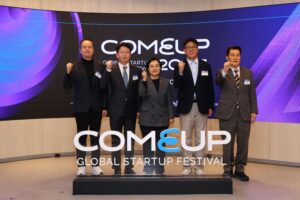Mahatma Gandhi called upon us to “be the change that you wish to see in the world.” As our economy continues to integrate people who see full time employment as a thing of the past, the Future of Work (FoW) is rapidly approaching. Whether you’re an entrepreneur, freelancer, or something in between, one thing distinguishes the future’s workforce more than anything else: they will change work to be their own in every conceivable way.
This trend has caused shared work spaces to become increasingly popular with workers who have had to adapt to a rapidly changing job market, where the shared economy and independent contractors have replaced many traditional jobs. Basically, someone can pay a fee at one of these places, and the shared work space provides a desk, a phone, WiFi, and coffee at a fraction of the cost of a traditional office. Often these spaces end up fostering collaboration between professionals with a wide range of skill-sets. This future of work concept has been fully embraced by the millennial generation, whose notions of a rigid work-life divide have been supplanted by a focus more on flexibility and being available at all hours.
No matter what your business is, you need suppliers, customers, and often collaborators. And if your business somehow doesn’t require social capital, independent workers will simply drive themselves insane without friends and a support network. Both are tough to develop and maintain while working from home or Starbucks.
COWORKING AS A CONCEPT
A little over a decade ago, Brad Neuberg open sourced his concept for co-working to address this vital need for the independent workforce to experience an office community. Since then over 10,000 co-working spaces have opened using the framework that Brad offered up to the world royalty free.
Much like the independent workers themselves, Brad’s intent was for everyone embracing his concept to make it their own. Despite the massive customization afforded by the entirely open source model, the core offerings of co-working spaces around the world are remarkably similar.
Indy Hall in Philadelphia is arguably the standard bearer and the oldest coworking space in the country that directly inherited this model. As Indy Hall’s founder Alex Hillman puts it, “We’ve always kept the ‘services’ simple: desk, chair, power, internet, and most importantly the friendly helpful people you can work alongside.”
Hillman highlights the fact that despite the stable model, what keeps changing is the people: “More diverse skillsets in the community means that there’s more people swapping what they know. More artists in the community means a more expressive visual aesthetic.”
In other words, what makes coworking such a powerful force in the FoW isn’t people sharing space; it’s people sharing ideas, experiences, and every other aspect of life they can with one another.
But the further these communities develop, the more we realize that community isn’t a single organism, but an entire ecosystem of community organisms cross-pollinating. Togetherness is empowering individuality and vice versa.
Indy Hall, while housing many micro-communities, is also part of other broader communities. One such community is N3RD St, named after the neighborhood Indy Hall and its members call home. Indy Hall members and staff co-created the N3RD St Farmers Market in 2013 and they have been meeting on Wednesdays ever since.
What struck Hillman the most about this experience was how deeply the market was activating relationships with neighbors whose presence was barely felt before. Hillman recalls, “I met more of our neighborhood neighbors in the first couple of hours of the farmers market than I had in the seven years prior. The market wasn’t just a place to go get food, it was a place to hang out and see neighbors. It was an excuse to bump into each other and chat.”
But it wasn’t just the customers who were connecting in new and interesting ways. The relationship amongst farming vendors also began to cross-pollinate. Hillman explains that “once vendors were building relationships, we started hearing about vendors sharing business & marketing tips with each other. Doors to wholesale deals were opened through a simple conversation that previously didn’t have a space to happen.”
With all this cross-pollination, it’s important to keep in mind that those participating are collaborating. Collaboration requires a safe space to conduct itself and trust between its members for collaboration to flourish. For instance, halfway across the country in the Rocky Mountain town of Fort Collins, CO, the Cohere coworking community was inspired to add an offering called Cohere Bandwidth precisely because it discovered a group of creatives that did not have a safe space to collaborate: musicians.
Cohere community member Julie Sutter recalls the breakfast when she approached Cohere founder and coworking luminary Angel Kwiatkowski. In between pancake bites, Sutter told Angel how “friends and members of the bands Bad Rabbit and Wire Faces got a nasty surprise when they discovered their shared band practice space had been robbed, picked entirely clean somewhere around Christmas Day.”
Armed with this cautionary tale of woe, Cohere built out their basement as a shared rehearsal space and opened it up for the community of musicians in Fort Collins to use as a service. But this service drew some unexpected groups such as “band moms who want some peace and quiet in their homes,” Sutter says, with some even joining Cohere as a result. Sutter adds, “Turns out there are plenty of musicians who are nerds, and plenty of nerds who are musicians, so the tech/band crossover has been fun.”
In the case of the farmers and the musicians, the cross-pollination happened naturally when these groups came in contact with the values and members of a coworking community.
NEW MODELS OF LEARNING
Up in Grand Rapids, Michigan Aaron Schaap, founder of The Factory, has been developing methods for a process he calls “coLearning,” which was inspired by the same nugget of wisdom that spurred the creation of coworking itself. As Schaap puts it, “Working by yourself all the time sucks, but so does learning all the time by yourself.”
The model works quite simply. People with skills to teach offer up a price to a class of 20, and then the community members that decide to join the class split the cost. What started as a six-week course teaching the programming language Ruby has transformed into a state accredited school with hundreds of alumni.
Schaap describes it as a “pop-up educational model” where students learn a lot more than the subject matter on the syllabi because they are learning as much from each other as they are from their instructors. Schaap maintains that “before you can be a better developer, designer or businessman, you need to be a better collaborator, communicator, [and] allow for more diversity in your thinking and the many other skills taught right alongside the things they initially signed up to learn.”
Aaron is also quick to note that educational graduations aren’t the only things his community celebrates. He tells us how “one of our members saw a bunch of expecting families and threw a baby shower with 40 other members to celebrate them.”
But Schaap is wise to caution us that the best ideas for embracing the FoW come from within and not just watching trends from other coworking spaces. “Worst thing you can do is watch other coworking spaces and try to do what they’re doing. For every good idea that you might get, you’ll get a thousand bad ideas,” he claims.
Instead, Schaap champions a simple guiding principle on how to embrace the future of work: “ it’s about being a community of people that generally care for one another and having a safe place to be themselves.”









